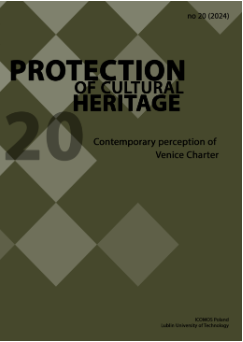Zabezpieczenia przeciwwilgociowe budowli podziemnych z użyciem gliny na przykładzie dzieł fortyfikacji nowożytnej oraz warszawskiego Elizeum
Abstrakt
Na podstawie analogii struktur budowli podziemnych – warszawskiego Elizeum i wielu obiektów fortecznych z XVIII-XIX w., artykuł podejmuje próbę zestawienia historycznych metod zabezpieczania ich wnętrz przed wilgocią przenikającą z nasypów, kondensacyjną, podciąganą kapilarnie lub dyfundującą z gruntu. Sposoby zabezpieczania przeciwwilgociowego w fortyfikacji nowożytnej zostały wypracowane w ciągu 4 wieków jej rozwoju (XVI-XIX), w wyniku stopniowego gromadzenia doświadczeń i wiedzy inżynierskiej. Ważnymi elementami tych zabezpieczeń były okładziny z gliny/iłu oraz korytarze obiegające pomieszczenia podziemne o funkcji nie tylko komunikacyjnej, ale również otuliny izolacyjno-wentylacyjnej. Budowle podziemne, poprawnie zaprojektowane na skrajnie niekorzystne warunki użytkowania, mogą trwać dzięki delikatnej równowadze, którą bardzo łatwo naruszyć. Pierwszym warunkiem równowagi jest utrzymanie właściwego reżimu wentylacji i ogrzewania wnętrz podatnych na kondensację. Na zakończenie zaproponowano działania pielęgnacyjno-eksploatacyjne mające na celu zahamowanie postępującej degradacji obiektu oraz zakreślono wskazania do programu badań i założeń przedprojektowych do przyszłych, niezbędnych prac remontowych i konserwatorskich.
Słowa kluczowe:
Zabytki, budowle podziemne, wilgoć, zabezpieczenia, glinaBibliografia
Dybaś B., Fortece Rzeczpospolitej. Studium z dziejów budowy fortyfikacji stałych w państwie polsko-litewskim w XVII wieku, wyd. 2, UMK Toruń 2018.
Google Scholar
Gutmejer K. (red.), Elizeum. Podziemny salon księcia. Dla Przyjaciół i Pięknych Pań (praca zbiorowa), wyd.: Miasto Stołeczne Warszawa 2016 r.
Google Scholar
Grzeszkiewicz-Kotlewska L., Szczepanik M., Opracowanie wyników badań archeologicznych przy ul. Wały gen. Sikorskiego 13 w Toruniu (2005-2007). Usługi Archeologiczno-Konserwatorskie, Toruń 2007. M-pis, archiwum Woj. Urzędu Ochrony Zabytków w Toruniu, sygn. W/3482.
Google Scholar
Hornowski, Wilgotność kazemat (podwalni) i sposoby jej usunięcia. (uwadze korzystających z kazemat-podwalni), Saper i Inżynier Wojskowy, R. 1925, s. 1159-1165. Przedruk INFORT nr 12 (1996), s. 12-14.
Google Scholar
Kwiatkowski M., Szymon Bogumił Zug architekt polskiego oświecenia, PWN Warszawa 1971.
Google Scholar
Narębski L., Tandecki J. (red.), Atlas Twierdzy Toruń: Zeszyt 6, Pokrzywnicki J., Bramy Twierdzy Toruń, Toruń 2013; Zeszyt 9, Pokrzywnicki J., Początki Pruskiej Twierdzy Toruń, Toruń 2016; Zeszyt 11, Wichrowski M., Narębski L., Pokrzywnicki J., Fort V – Chodkiewicz (Fort III – Scharnhorst), Toruń 2018. Wyd.: Towarzystwo Naukowe w Toruniu, Towarzystwo Przyjaciół Fortyfikacji w Toruniu.
Google Scholar
Podruczny G., Przerwa T., Twierdza Srebrna Góra, wyd. Bellona 2010.
Google Scholar
Prittwitz M. v., Beitrage zur angewandten Befestigungskunst, erläutert durch Beispiele aus der neuern Preußischen Befestigungsanlagen auf 100 Tafeln, Posen 1836.
Google Scholar
Ratke M, Charakterystyka gleb antropogenicznych na wybranych fortyfikacjach w Toruniu. Praca mgr, Zakład Gleboznawstwa Wydz. Biologii i Nauk o Ziemi UMK w Toruniu. M-pis, Toruń 2004.
Google Scholar
Rouba B. J., Badania klimatyczne a problematyka konserwatorska, Od badań do konserwacji – Materiały konferencji – Toruń 23-24 10 1998, Wyd. UMK Toruń 2002, s. 193-198.
Google Scholar
Stawicki R., Dzieje Szkoły Rycerskiej – Korpusu Kadetów w latach 1765–1794. Biuro Analiz i Dokumentacji Kancelarii Senatu, Warszawa, 2015.
Google Scholar
Wagner R. v., Sammlung technischer Bestimmungen für Fortifikations-, Artillerie- und Garnison-Bauten, Berlin 1881.
Google Scholar
Statystyki
Abstract views: 314PDF downloads: 314 PDF downloads: 104
Licencja

Utwór dostępny jest na licencji Creative Commons Uznanie autorstwa – Na tych samych warunkach 4.0 Miedzynarodowe.








